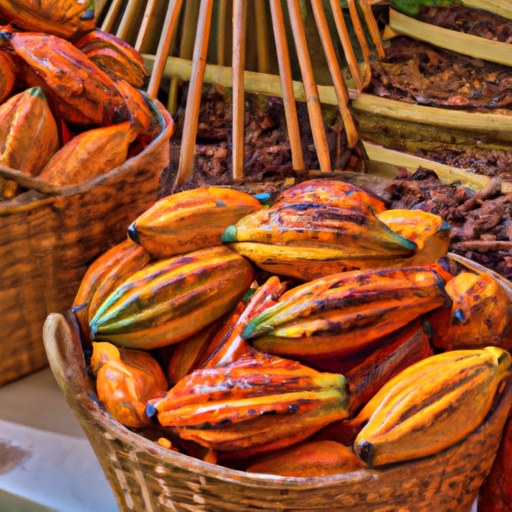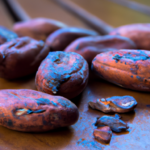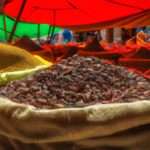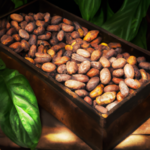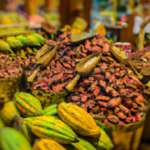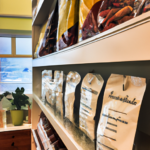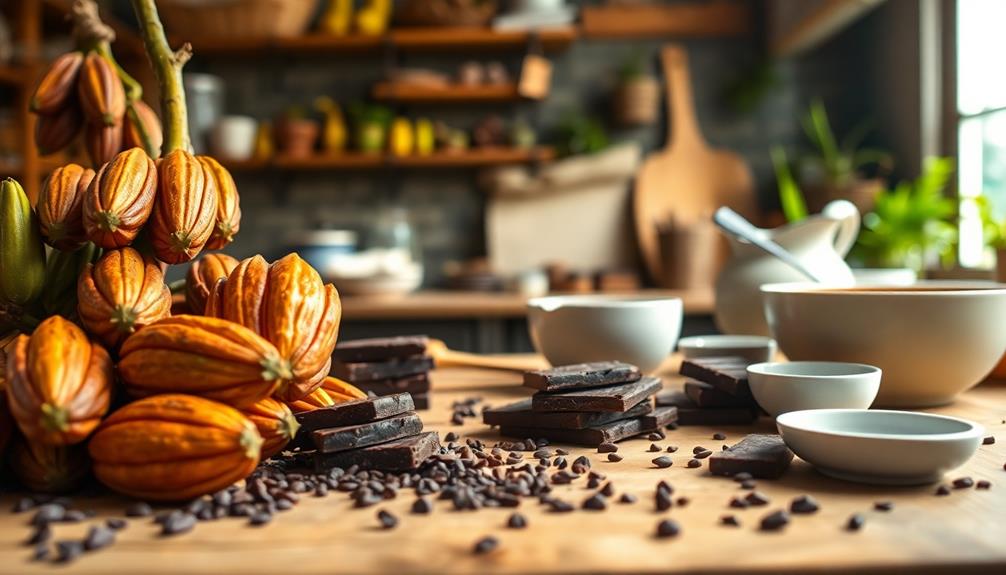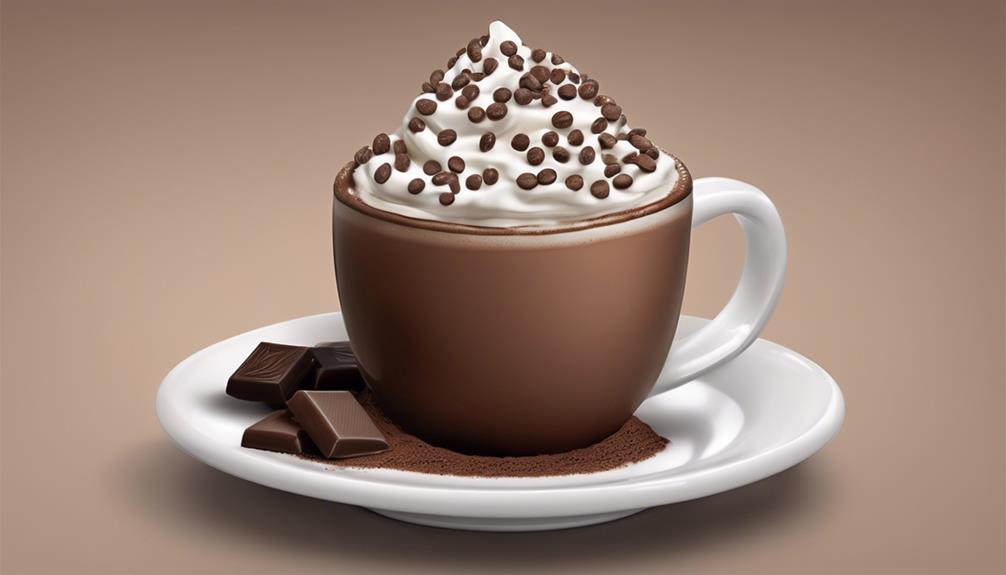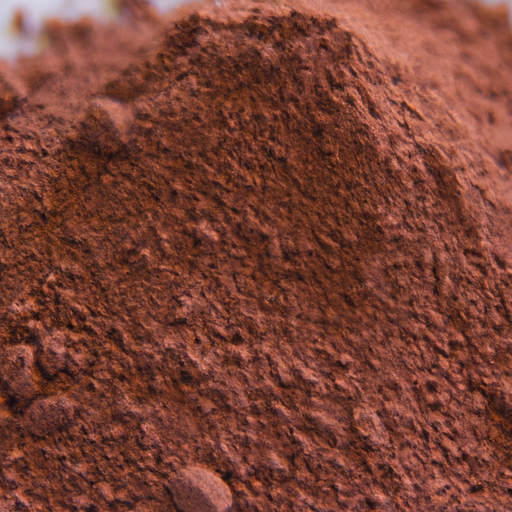I happened to discover a small bag of raw cacao beans at my local health food store recently. Intrigued by their decadent chocolate scent, I couldn’t help but bring them home to delve into the world of raw cacao.
Little did I know that these humble beans would become my new obsession. Raw cacao beans are not only a delicious indulgence, but they are also packed with nutrients and health benefits.
From homemade chocolate treats to nutrient-boosting smoothies, there are countless ways to incorporate raw cacao beans into your daily routine. In this article, I will guide you through the wonderful world of raw cacao beans and show you how to harness their incredible potential.
Get ready to embark on a chocolate-filled adventure that will delight your taste buds and nourish your body. Let’s delve into the wonders of raw cacao beans together!
Key Takeaways
- Raw cacao beans can positively impact brain function and serotonin levels.
- The magnesium content in raw cacao beans helps with relaxation and stress reduction.
- Raw cacao beans are rich in antioxidants and minerals.
- There are various ways to incorporate raw cacao beans into your diet, such as using raw cacao bean powder in recipes and creating delicious chocolate smoothies.
Understanding the Benefits of Raw Cacao Beans
Get ready to discover the incredible perks of raw cacao beans and how they can supercharge your health!
Understanding the origins of raw cacao beans is essential to truly appreciate their benefits. These magical beans come from the cacao tree, which is native to Central and South America.
The process of fermenting raw cacao beans is crucial in developing their distinct flavor and unlocking their nutritional potential. During fermentation, the beans are left to ferment in their pulp, which enhances their rich taste and reduces bitterness. This process also helps break down complex compounds, making the nutrients more bioavailable to our bodies.
Now that we understand the origins and fermentation process of raw cacao beans, let’s move on to the exciting world of making homemade chocolate treats with these remarkable beans!
Making Homemade Chocolate Treats with Raw Cacao Beans
Indulge yourself in the ultimate chocolate experience by transforming those magical little cocoa seeds into mouthwatering homemade treats. Making homemade chocolate bars and raw cacao bean truffles is a delightful way to enjoy the rich flavors and health benefits of raw cacao beans.
Raw cacao beans contain a high concentration of antioxidants, minerals, and natural compounds that promote heart health, improve mood, and boost cognitive function. By using raw cacao beans in your homemade chocolate treats, you can ensure that you are getting the maximum nutritional value from this superfood.
Whether you prefer a dark and velvety chocolate bar or a decadent truffle, the possibilities are endless when it comes to creating your own delectable treats.
Now, let’s explore how to incorporate raw cacao beans into smoothies for a nutrient boost.
Adding Raw Cacao Beans to Smoothies for a Nutrient Boost
Enhance your smoothie’s nutritional value with a nutrient boost by incorporating the magical little cocoa seeds, transformed into mouthwatering homemade treats. Adding raw cacao beans to your smoothies not only imparts a rich, chocolaty flavor but also provides a wealth of nutrients.
These beans are packed with antioxidants, which help protect your body against free radicals and reduce inflammation. Additionally, cacao beans are a great source of magnesium, iron, and fiber, all of which contribute to a healthy diet.
Using cacao beans in savory dishes is also a wonderful way to explore their versatility. They can be ground and used as a spice in meat rubs or added to chili for a subtle, earthy flavor.
The history and origin of cacao beans is fascinating. They were first cultivated by the ancient Mayans and Aztecs in Central America, who valued them for their medicinal properties and used them in religious ceremonies. Today, cacao beans are grown in various tropical regions around the world, including South America, Africa, and Asia.
Transitioning into the subsequent section about creating delicious desserts with raw cacao beans, these beans are truly a culinary treasure, offering endless possibilities for indulgent treats.
Creating Delicious Desserts with Raw Cacao Beans
Satisfy your sweet tooth and unlock a world of delectable desserts by harnessing the power of these magical cocoa seeds. Raw cacao beans not only add a rich and intense chocolate flavor to desserts, but they also offer numerous health benefits.
Did you know that raw cacao beans can be used in skincare products? They contain antioxidants that help protect the skin from free radicals, reducing signs of aging and promoting a healthy glow.
Additionally, you can even create raw cacao bean infused cocktails for a unique and indulgent treat.
From chocolate mousse to brownies, there are endless possibilities when it comes to incorporating raw cacao beans into your favorite desserts.
So, let’s dive into exploring different ways to incorporate raw cacao beans in baking, and discover a whole new level of chocolatey goodness.
Exploring Different Ways to Incorporate Raw Cacao Beans in Baking
Get ready to elevate your baking game with an unexpected twist that will leave your taste buds craving for more.
When it comes to incorporating raw cacao beans in baking, the possibilities are endless. Not only do they add a rich, chocolatey flavor, but they also offer different flavor profiles depending on how they are prepared.
For a more intense taste, grind the beans into a fine powder and use it in place of cocoa powder in your favorite recipes. You can also add whole cacao beans to your cookie dough or cake batter for a delightful crunch.
But don’t limit yourself to just sweet treats! Get creative and experiment with incorporating cacao beans in savory dishes like chili or mole sauce. The earthy, slightly bitter taste of the beans adds depth and complexity to these dishes.
So go ahead, explore the world of cacao beans in baking and watch as your creations reach new heights of deliciousness.
Now, let’s move on to making energizing raw cacao bean snacks.
Making Energizing Raw Cacao Bean Snacks
Indulge your taste buds with energizing snacks that harness the power of raw cacao beans.
Not only are raw cacao beans delicious, but they also provide a natural energy boost.
One way to enjoy the energizing benefits of cacao beans is by making cacao bean drinks.
Simply blend raw cacao beans with your favorite plant-based milk and sweeten with a natural sweetener like dates or maple syrup.
This creamy and luscious drink will give you a burst of energy and satisfy your chocolate cravings.
Additionally, you can incorporate raw cacao beans in your breakfast recipes.
Sprinkle crushed cacao beans on top of oatmeal or mix them into homemade granola for a nutritious and energizing start to your day.
Now, let’s explore how to use raw cacao beans in hot beverages for a rich and indulgent flavor.
Using Raw Cacao Beans in Hot Beverages for a Rich and Indulgent Flavor
Enhance your hot beverage experience with the rich and indulgent flavor of raw cacao beans. Have you ever tried adding these little gems to your favorite steaming drink? Raw cacao beans can be a wonderful addition to hot chocolate or cacao infused coffee. They provide a deep and complex taste that will elevate your beverage to a whole new level.
The natural bitterness of the cacao beans perfectly complements the sweetness of hot chocolate, creating a harmonious balance of flavors. In cacao infused coffee, the beans impart a subtle chocolatey note that adds depth and richness to each sip. The result is a truly decadent and satisfying drink that will have you craving for more.
Now, let’s delve into the next section and discover the health benefits of raw cacao bean powder.
Discovering the Health Benefits of Raw Cacao Bean Powder
Uncover the numerous health benefits that come with incorporating raw cacao bean powder into your daily routine.
Raw cacao beans are packed with antioxidant properties, which can help protect your body against harmful free radicals and promote overall health.
Additionally, research suggests that raw cacao beans may play a role in improving mood and reducing stress. The rich presence of flavonoids in raw cacao beans has been linked to a potential positive impact on brain function and serotonin levels.
Furthermore, the magnesium content in raw cacao beans can contribute to relaxation and stress reduction.
So, by incorporating raw cacao bean powder into your diet, you can potentially experience these amazing health benefits.
Now, let’s transition into the next section and embark on a chocolate-filled adventure by experimenting with raw cacao bean recipes.
Experimenting with Raw Cacao Bean Recipes for a Chocolate-Filled Adventure
After discovering the numerous health benefits of raw cacao bean powder, I was inspired to delve further into the world of raw cacao and explore its versatility in creating delectable treats.
One of my favorite ways to incorporate raw cacao beans into my diet is by experimenting with chocolate smoothie recipes. These smoothies not only satisfy my chocolate cravings but also provide a rich source of antioxidants and minerals. From creamy almond butter and cacao smoothies to refreshing mint chocolate chip blends, the options are endless and delicious.
Additionally, I have discovered that raw cacao beans can be used in skincare routines to enhance the radiance and health of the skin. By grinding the beans into a fine powder and mixing them with natural ingredients like honey or coconut oil, I have created nourishing face masks and scrubs that leave my skin glowing and rejuvenated.
Embracing raw cacao beans has truly been a chocolate-filled adventure for both my taste buds and my skin.
Frequently Asked Questions
How do I store raw cacao beans to maintain their freshness?
To maintain the freshness of raw cacao beans, I investigated various storing methods. I found that storing them in an airtight container in a cool, dark place can extend their shelf life for up to two years.
Can I eat raw cacao beans directly, or do they need to be processed in some way?
Raw cacao beans can be eaten directly or used in raw cacao recipes. They offer numerous health benefits, such as being rich in antioxidants and providing a natural source of energy.
Are there any potential side effects or risks associated with consuming raw cacao beans?
There are potential side effects associated with consuming raw cacao beans in excessive amounts. However, when consumed in moderation, raw cacao beans offer several potential health benefits. It is important to stick to the recommended daily intake.
Can raw cacao beans be used as a substitute for cocoa powder in baking recipes?
Yes, raw cacao beans can be used as a substitute for cocoa powder in baking recipes. They provide numerous benefits such as high antioxidant content and enhanced flavor, making them a healthier option.
Are there any specific nutritional considerations or guidelines when using raw cacao beans in smoothies or desserts?
When using raw cacao beans in smoothies or desserts, it is important to consider their nutritional benefits and culinary uses. They are rich in antioxidants and minerals, and can be ground or melted for various recipes.
What Are Some Ways to Incorporate Raw Cacao Beans Into Recipes?
Raw cacao bean uses can be incorporated into recipes in various ways. You can blend them into smoothies for a rich chocolate flavor, sprinkle them on top of your morning oatmeal, or add them to homemade energy bars for an extra boost. Try experimenting with different dishes to discover new favorite ways to enjoy raw cacao beans.
Conclusion
In conclusion, I have explored the various ways to use raw cacao beans and discovered their numerous benefits. From making homemade chocolate treats to adding them to smoothies and desserts, there are endless possibilities for incorporating raw cacao beans into our diets.
Not only are they delicious, but they also provide a nutrient boost and offer several health benefits. So, why not embark on a chocolate-filled adventure and experiment with these chocolate gems?
As the saying goes, "Life is like a box of chocolates, you never know what you’re gonna get." But one thing is for sure, you’ll always get a delightful and indulgent treat.


